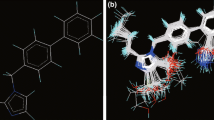Abstract
A series of 47 indole-3-carboxamide derivatives with their renin inhibitors were subjected to QSAR to derive a correlation between biological activity as a dependent variable and various descriptors as independent variables. The best 2D-QSAR model having cross-validated squared correlation coefficient q 2 = 0.7847 with external predictive of pred_r 2 = 0.8193. Based on k-nearest neighbor method the results some key structural factors responsible for renin inhibitors of this series of compounds were revealed as follows: the substituent R1 should have higher steric potential is favorable and substituent R2, and R3 position electron donating group may be favorable. The structural insights gleaned from the study could be usefully employed to design activators with a much more enhanced potency.






Similar content being viewed by others
References
Ajmani S, Jhadav K, Kulkarni SA (2006) Three-dimensional QSAR using the k-nearest neighbor method and its interpretation. J Chem Inf Mod 46:24–31
Ballermann BJ, Zeidel ML, Gunning ME, Brenner BM.Vasoactive peptides and the kidney. In: B.M. Brenner, F.C. Rector (Eds.), The kidney, W.B. Saunders Company, Philadelphia 1991, pp 510–583
Baumann K (2002) An alignment-independent versatile structure descriptor for QSAR and QSPR based on the distribution of molecular features. J Chem Inf Comput Sci 42:26–35
Brunner NR, Nussberger J, Waeber B (1995) Effects of angiotensin converting enzyme inhibition: a clinical point of view. J Cardiovasc Pharmacol 7(4):73–81
Cramer RD, Patterson DE, Bunce JD (1988) Comparative molecular field analysis (CoMFA). 1. Effect of shape on binding of steroids to carrier proteins. J Am Chem Soc 110:5959–5967
da Mota Estella G, Duarte Mariene H, da Elaine Cunha FF, Matheus Freitas P (2015) Theoretical design of new indole-3-carboxamide derivatives as renin inhibitors. Med Chem Res 24:3097–3106
Darlington RB (1990) Regression and linear models. McGraw-Hill, New York
Ekins S, Waller CL, Swaan PW, Cruciani G, Wrighton SA, Wikel JH (2000) Progress in predicting human ADME parameters in silico. J Pharmacol Toxicol Methods 44(1):251–272
Frampton JE, Curran MP (2007) Aliskiren: a review of its use in the management of hypertension. Drugs 67:1767–1792
Golbraikh A, Tropsha A (2002) Predictive QSAR modeling based on diversity sampling of experimental datasets for the training and test set selection. J Comput Aided Mol Des 16:357–369
Hackenthal E, Paul M, Ganten D, Taugner R (1990) Morphology, physiology, and molecular biology of renin secretion. Physiol Rev 70:1067–1116
Halgren TA (1996) Merck molecular force field. III. Molecular geometries and vibrational frequencies for MMFF94. J Comput Chem 17:553–586
Holland JH (1992) Genetic algorithms. Sci Am 267:66–72
Johnston CI.Angiotensin converting enzyme inhibitors A. In: Zanchetti, R.C Tarazzi (Eds.), Handbook of Hypertension, Elsevier, Amsterdam, The Netherlands; 1984, p272–311
Moiz MS, Dileep VM, Ronald GV (2008) Oral direct renin inhibition: premise, promise, and potential limitations of a new antihypertensive drug. Am J Med 121:265–271
Paul M, Poyan MA (2006) Kreutz R Physiology of local renin-angiotensin systems. Physiol Rev 86:747–803
Perkins R, Fang H, Tong W, Welsh WJ (2003) Quantitative structure-activity relationship methods: perspectives on drug discovery and toxicology. Environ Toxicol Chem 22(8):1666–1679
VLife MDS 3.5. Molecular design suite. Vlife Sciences Technologies Pvt. Ltd. Pune, India, 2008
Scheiper B, Matter H, Steinhagen H, Stilz U, Böcskei Z, Fleury V, McCort G (2010) Discovery and optimization of a new class of potent and non-chiral indole-3-carboxamide-based renin inhibitors. Bioorg Med Chem Lett 20:6268–6272
Verma J, Khedkar VM (2010) Coutinho EC.3D-QSAR in drug design-a review. Curr Top Med Chem 10:95–115
Wuerzner G, Azizi M (2008) Renin inhibition with Aliskiren. Clin Exp Pharmacol Physiol 35:426–430
Zheng W, Tropsha A (2000) Novel variable selection quantitative structure–property relationship approach based on the k-nearest neighbor principle. J Chem Inf Comput Sci 40:185–194
Acknowledgments
The author would like to thank VLife Sciences Technologies Pvt. Ltd. Pune for providing software facility.
Author information
Authors and Affiliations
Corresponding author
Ethics declarations
Conflict of interest
Author declare no conflict of interest.
Rights and permissions
About this article
Cite this article
Sharma, M.C. Computational design of novel renin inhibitors of indole-3-carboxamide derivatives through QSAR studies. Netw Model Anal Health Inform Bioinforma 5, 9 (2016). https://doi.org/10.1007/s13721-016-0116-7
Received:
Accepted:
Published:
DOI: https://doi.org/10.1007/s13721-016-0116-7




